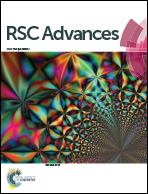Enhancing the dual magnetic and optical properties of co-doped cerium oxide nanostructures†
Abstract
In spite of the potential biomedical application, ceria nanoparticles suffer from poor optical and magnetic properties. Here we report the structural, optical and magnetic properties of iron (8 at%) and europium (1 at%) co-doped ceria nanoparticles with respect to annealing temperature. A cubic fluorite structure of ceria was observed on co-doping but an additional α-Fe2O3 phase emerged on annealing at 700 °C and above. An increase in the mean crystallite size from 6.5 to 37 nm and a corresponding reduction in strain was observed with annealing temperature. Surface area and scanning electron microscopic studies indicated a porous structure which became dense upon annealing. Raman spectroscopic studies reveal the presence of oxygen vacancy defects arising from the combination of intrinsic and extrinsic defects due to the presence of Ce3+ and dopant, respectively. X-ray photoelectron spectroscopic results confirm the oxidation of Ce3+ to Ce4+ state while the trivalent state of iron was retained on annealing at higher temperatures. On annealing above 500 °C, reduction in defect concentration improved the emission intensity primarily through magnetic dipole transition. A typical ferromagnetic behaviour was noticed in all the samples and shift a from soft to hard magnetic behaviour upon annealing.


 Please wait while we load your content...
Please wait while we load your content...